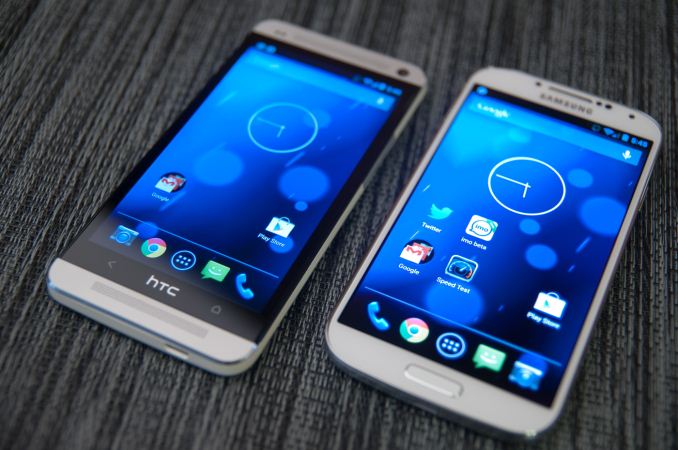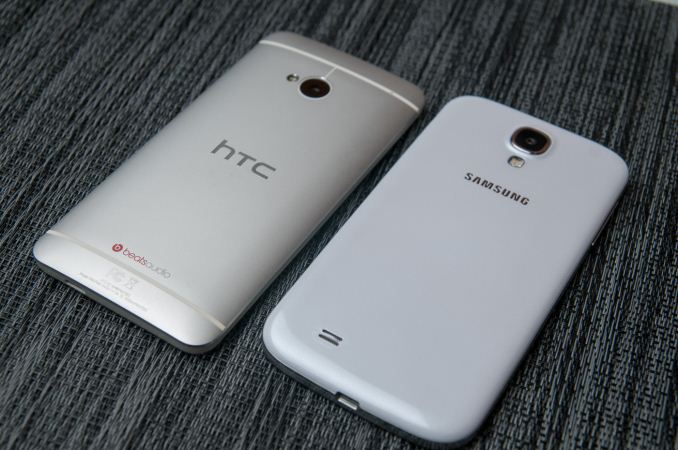HTC One and Samsung Galaxy S 4 Google Play edition Review - Nearly Nexus
by Brian Klug on June 26, 2013 1:00 PM EST- Posted in
- Smartphones
- Android
- Mobile
- google play
- Android 4.2

Back at Google I/O, the search giant announced the Samsung Galaxy S 4 with Nexus User Experience, a device which combined Samsung's SGS4 hardware and the stock Android experience atop it. Later on, HTC made an announcement of its own about an upcoming HTC device with the same exact promise – unadulterated HTC One hardware running unadulterated Android. Both devices originally didn't have formal names, they're now the Samsung Galaxy S 4 Google Play edition and HTC One Google Play edition, respectively (henceforth SGS4 GPe or HTC One GPe).
Google I/O went on to be a not so subtle breakdown of Google's strategy to de-couple more of the platform from the primary point releases of Android to get more consistent user experiences and APIs across the ecosystem. While many expected new hardware and a new version of Android, although both were teased, the real big news was primarily Google solidifying more of the experience consistency for developers and users alike. If you look at that theme from a higher level, you can see how Google also clearly wants to extend this to hardware through an ambitious new Google Play edition initiative which starts with the HTC One and Galaxy S 4 Google Play editions. The hardware is already a known entity – we've reviewed both the HTC One and the Snapdragon 600-based Galaxy S 4 – the question is how that experience works with stock Android.
The obvious goal of both Google Play editions is simple – the Nexus phone isn't on a fast update cadence, so taking advantage of the flagship smartphone hardware from both HTC and Samsung is an easy way for Google to keep its offerings fresh. The promise is the combination of smartphone hardware that will remain the best of the best through Fall 2013 and the latest and greatest Android software release (4.2.2 right now and later on probably 4.3 like I've previously speculated) updated in a timely fashion.
There's a precedent for Google doing some this under the umbrella of "Google Experience Devices" with the Motorola Xoom and TI PandaBoard. The new phrase at Google I/O was "Nexus User Experience," but interestingly enough the final one is "Google Play edition," distancing it a bit more from being canonical Nexus. It's clear that Google's Nexus strategy isn't going away, it is however clearly changing. We'll touch on the software update and who-builds-what side of things in the appropriate section.
Anyhow the HTC One and SGS4 are both known entities, and the hardware here should be familiar to anyone who has read those reviews or any others. The fact that both are Google Play edition simply means they carry no operator branding. There's no AT&T logo etched into the back of the HTC One nor SGS4, no operator adulteration anywhere. The GPe versions won't fundamentally change anyone's mind about whether the HTC One or SGS4 is the better hardware, since the intrinsic properties of both are unchanged. Likewise there's still a microSD card slot and removable battery on the SGS4, and the HTC One still has its phenomenal metal unibody construction and UltraPixel camera. What is and isn't enabled really comes down to software, but again more on that in the appropriate section.
The pricing announcement for the SGS4 GPe drew audible booing from the crowd during Google I/O, something that struck me as odd and shocking for what should be a reasonably savvy audience. The reality is that there's no way Google, Samsung, or HTC would massively undercut flagship device pricing mid-cycle with prices either near cost or offset with an invisible subsidy. This isn't a Nexus 4, it's another OEM's hardware running software Google has dictated, and as a result the two phones come in at around typical unsubsidized pricing. That translates to $599 for the 32 GB HTC One and $649 for the 16 GB SGS4. Both are live on the Play Store (link below) as of this posting.
| Google Play edition Comparison | |||||
| HTC One GPe | Samsung Galaxy S 4 GPe | ||||
| Equivalent Operator Variant |
AT&T USA (M7#UL ATT - PN07120) |
T-Mobile USA (GT-I9505G, really SGH-M919) |
|||
| SoC | 1.7 GHz Qualcomm Snapdragon 600 (APQ8064T) | 1.9 GHz Qualcomm Snapdragon 600 (APQ8064AB) | |||
| Display | 4.7-inch 1080p LCD | 5.0-inch 1080p SAMOLED | |||
| RAM | 2 GB LPDDR2 | 2 GB LPDDR3 | |||
| Wireless Connectivity |
802.11a/b/g/n/ac, BT 4.0 (BT 4.0 w/next Android release) |
802.11a/b/g/n/ac, BT 4.0 (BT 4.0 w/next Android release) |
|||
| Storage | 32 GB internal | 16 GB internal, microSDXC | |||
| I/O | microUSB 2.0 | microUSB 2.0 | |||
| Camera |
4.0 MP with 2.0µm pixels (rear) |
13 MP with 1.1µm pixels (rear) |
|||
| OS | Android 4.2.2 | Android 4.2.2 | |||
| Price | $599 (Google Play) | $649 (Google Play) | |||
| Network Support |
Quad Band GSM/EDGE WCDMA Bands: 1 (2100), 2 (1900), 5 (850) LTE Bands: 2 (1900), 4 (1700/2100), 5 (850), 17 (700) |
Quad Band GSM/EDGE WCDMA Bands: 1 (2100), 2 (1900), 4 (1700/2100), 5 (850) LTE Bands: 1 (2100), 2 (1900), 4 (1700/2100), 5 (850), 7 (2600), 17 (700) |
|||
The GPe versions are aimed at the US market and variants with the appropriate banding were selected for this purpose. Google didn't (and for timing reasons basically cannot) make Samsung or HTC craft new variants, thus existing ones were used. In the case of the HTC One GPe, that's the AT&T USA (M7#UL ATT), same as the factory unlocked and developer editions. In the case of the SGS4 GPe this translates to the T-Mobile USA variant (SGH-M919) which is the same as the AT&T (SGH-I337) variant but without the pointless and arbitrary operator-requested RAT locks that prevent Band 4 WCDMA from working. Likewise I find myself wishing that HTC would disable those locks which prevent Band 4 WCDMA from working on their developer edition, unlocked edition, and GPe, though that would require FCC involvement since it lacks certification.
Anyhow the layman's translation is that the SGS4 GPe and HTC One GPe work out of the box on AT&T and T-Mobile LTE. The SGS4 GPe will work on all of T-Mobile and AT&T HSPA+, HTC One GPe will work on all of AT&T HSPA+ but only Band 2 (1900 MHz) T-Mobile HSPA+. The HTC One GPe will not work on T-Mobile's Band 4 HSPA+, only its Band 4 LTE. If you're on Sprint or Verizon CDMA/LTE and care about having Nexus phones you're again on the wrong side of the fence and probably will be for the foreseeable future. I tested both T-Mobile and AT&T personal SIMs in both devices, and had no issues with them attaching flawlessly to LTE and HSPA+ on the respective networks.


















81 Comments
View All Comments
teiglin - Wednesday, June 26, 2013 - link
I echo the request for a game-related benchmark or five. At the very least one benchmark of a simple/puzzle game (Cut the Rope or whatever), and a 3D/more GPU-intensive game (though this is admittedlyproblematic with the rate of change of ARM silicon and generally high turnover of mobile games, anything relatively recent would satisfy me)apertotes - Wednesday, June 26, 2013 - link
I would like to ask those with a larger experience than me how many of these devices' drawbacks are completely amended with a simple trip through google play. For example, the camera interface. Stock camera is bad. Install Camera 360 or Camera FX. So, take any of these phones and give it to a experienced user, and after 1-2 weeks of tweaking (not counting installing new roms, or else what's the point?), they may as well have gotten rid of any drawback whatsoever.coldpower27 - Wednesday, June 26, 2013 - link
Yeah, people want the phone to be great out of the box, not have to tweak like mad to get rid of the drawbacks, there shouldn't be issues to begin with.apertotes - Thursday, June 27, 2013 - link
downloading 5 apps and changing some settings is not tweaking like mad.DukeN - Thursday, June 27, 2013 - link
Maybe it's just me but there are a lot of things touchwiz does that stock Android lacks. Even with apps like Camera FX and custom ROMs (liquidsmooth, paranoid, stock CM are ones I tried) I couldn't mimic some of Touchwiz' basic timesavers.Slide to call/message is indispensable for me. Also the camera app with Touchwiz is drastically better than AOSP, and frankly both third party camera apps off Google Play aren't as intuitive IMO.
Also the one touch drag-down top menu in Touchwiz is unique with brightness and other settings, some of the ROMs let you setup for wireless radio control but it takes quite a bit of tweaking.
I'm probably in the minority here but after going through a few Android devices, I'd probably take Touchwiz over stock AOSP.
Drazick - Wednesday, June 26, 2013 - link
Does the SGS4 GPe still has the Slide to Call / SMS?thesavvymage - Thursday, June 27, 2013 - link
My nexus 4 doesnt so the chance the sgs4 has it is next to 0. Theyre runnign the same build of android, so if the n4 doesnt have it the sgs4 wont either. There are NO samsung customizations hereumadBRAH - Wednesday, June 26, 2013 - link
Htc one on Sunspider 0.9.1 I get 760ms - 780ms on 1.29.xxx.13 and on 4.2.2 alsoteiglin - Wednesday, June 26, 2013 - link
It still boggles my mind that HTC (or Google?) didn't pick the UMTS-over-AWS-enabled version of the One for this like the GS4. Seriously, what the #@#%$?Anyway, not many surprises here. I would definitely dispute your advice that anyone who knows what AOSP is shoudl get the google editions--band options aside, I think anyone who is comfortable flashing a custom ROM is better off getting a better price from their operator. Especially with an easy S-OFF available for the One, there is only danger to your warranty if you're either foolish or experimental. I think the segment of people who should buy these is a rather small slice--those who know enough about Android to want the stock experience, but are not savvy enough to be comfortable flashing a custom ROM. For everyone else, there are better options available--whether operator-subsidized from AT&T or just flat-out $20 less from T-Mobile. Not to mention alternate colors, if that's your thing.
For myself, I already have a tmo One and will likely give CM another try once full code gets released to AOSP and presumably the niggling little bugs are worked out (did I hear you say bluetooth?). That said, I don't see myself wanting to live with the stock camera app, which was a big part of the reason I ditched my Nexus 4 in the first place, and while the Sense Gallery app is needlessly complicated, I do like the features it offers. Pretty much everything else is cosmetic, and that is easy to change.
The0ne - Wednesday, June 26, 2013 - link
Agreed. But comparing stock apps is valid if you're sole purpose is to do that. But the marketplace is there for a good reason and absolutely no one escapes it by not trying new and different apps. There are drawbacks to using 3rd party apps however and there are expectations of an OEM app but this is really all meh as options are widely available to chose from.